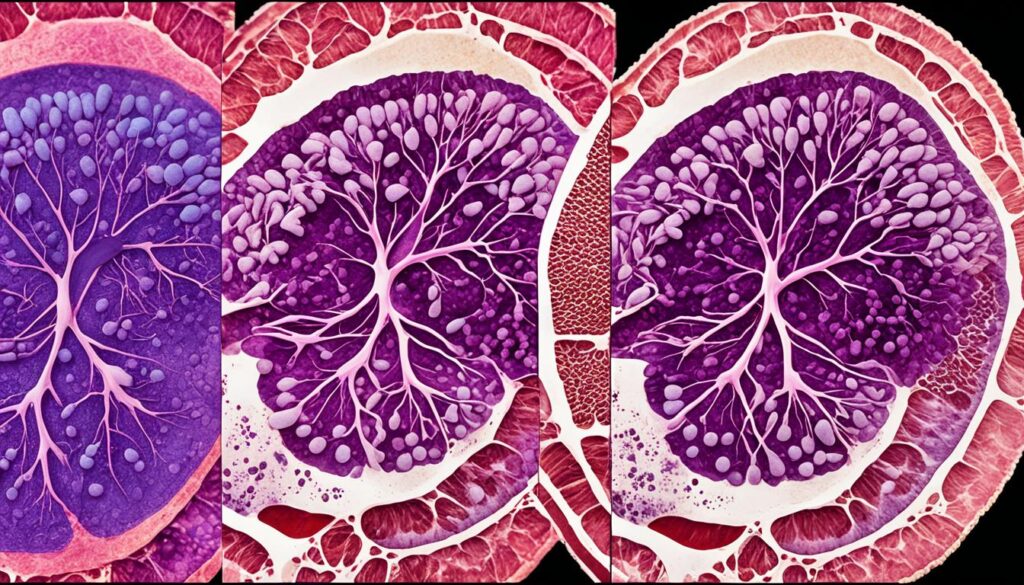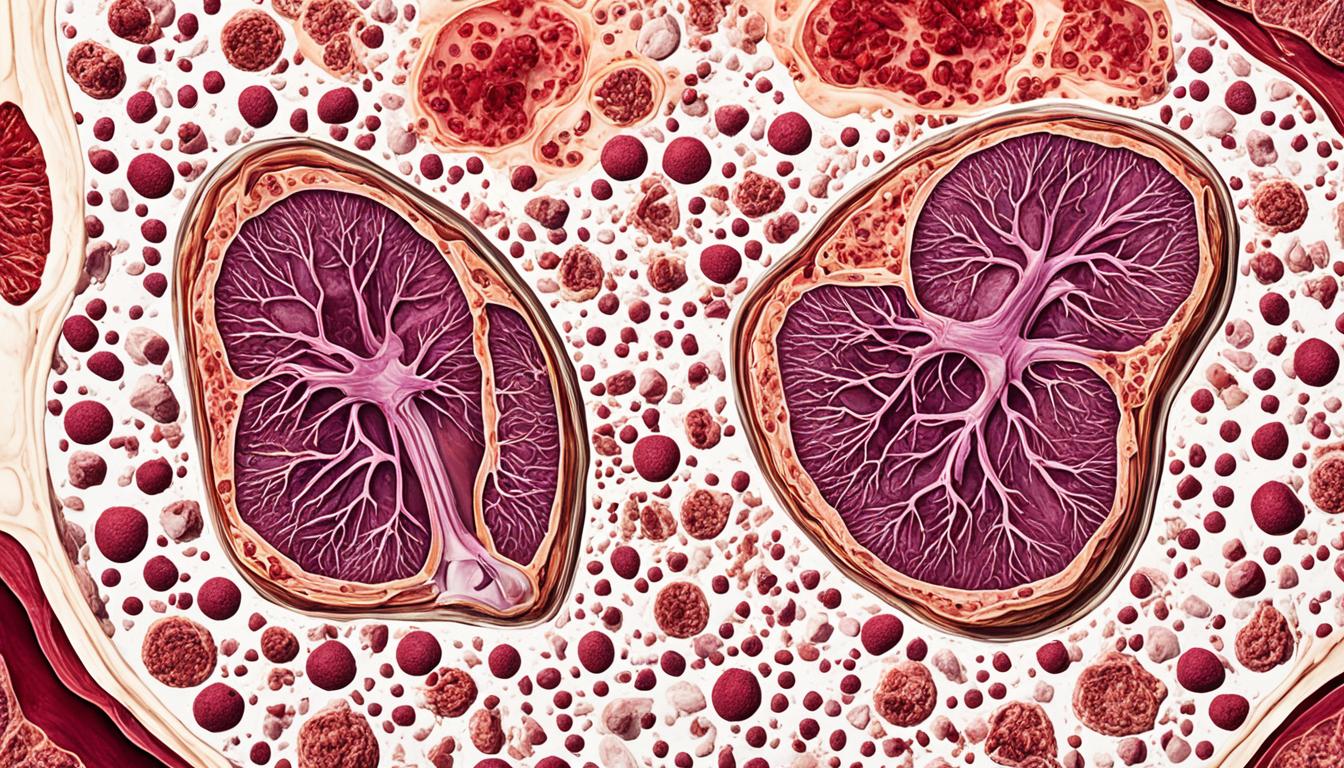Did you know cirrhosis impacts millions all over the world? This disease is a big health issue, affecting people from every walk of life. It can come from chronic alcoholism, viral hepatitis, or other sources. It’s a major risk to health for many.
Key Takeaways:
- Cirrhosis at the liver is a prevalent and serious health condition.
- Multiple causes, including chronic alcoholism and viral hepatitis, contribute to its development.
- Early detection and proper management can significantly improve outcomes for individuals with cirrhosis at the liver.
- Implementing preventive strategies and lifestyle modifications can help reduce the risk of developing cirrhosis.
- Understanding the stages and complications of cirrhosis aids in making informed decisions regarding treatment and lifestyle choices.
Causes of Cirrhosis
It’s crucial to know what causes cirrhosis in the liver to catch it early and avoid it. Causes include drinking a lot over time, viruses like hepatitis, and a liver disease from too much fat.
Chronic Alcoholism
Drinking too much alcohol for a long time harms the liver a lot. It makes the liver swollen and scared, so it can’t work right.
Viral Hepatitis
Viruses, especially hepatitis B and C, harm the liver too. They cause swelling and damage. Without treatment, this can lead to cirrhosis.
Non-Alcoholic Fatty Liver Disease
Too much fat in the liver, without alcohol, can also cause problems. This makes the liver swollen and scared. It can happen because of obesity, high cholesterol, and diabetes type 2.
“The causes of cirrhosis are multifactorial, with chronic alcoholism, viral hepatitis, and non-alcoholic fatty liver disease being the primary contributors.”
There are many causes of cirrhosis. Some get it from more than one of these reasons or other health issues like autoimmune hepatitis or genetic liver diseases.
| Cause | Description |
|---|---|
| Chronic Alcoholism | Prolonged and excessive alcohol consumption leads to inflammation and scarring of the liver tissue. |
| Viral Hepatitis | Hepatitis B and C viruses attack liver cells, causing inflammation and liver damage. |
| Non-Alcoholic Fatty Liver Disease | Excess fat accumulation in the liver leads to inflammation and scarring. |
We must treat the causes of cirrhosis and make life changes to stop cirrhosis from getting worse. Finding it early and getting the right help can more than double someone’s chances of getting better.
Symptoms and Diagnosis of Liver Cirrhosis
To find liver cirrhosis early, knowing its symptoms is key. Many feel tired, see yellow skin, and have belly pain. These are common signs.
Fatigue means feeling tired all the time without reason. It can make life hard. Doing daily tasks becomes a struggle.
Jaundice causes yellow skin and eyes. It happens when bilirubin collects in the body. You might also have dark pee, light poo, and feel itchy.
Belly pain is quite common with cirrhosis. It can be dull or sharp, usually on the upper right side. Sometimes it’s because the liver is bigger or from fluid buildup in the belly.
Diagnostic Methods
Doctors use different tests for diagnosing liver cirrhosis.
- Blood tests: They are key in checking liver health and blood work. They find issues and check blood for certain things.
- Imaging scans, like ultrasound, CT scans, and MRI, show the liver inside. They look for scars, nodules, or changes.
- A liver biopsy takes a tiny bit of liver for a close look. It tells how bad the liver damage is and if there are other liver diseases.
By looking at all these tests together, doctors can accurately diagnose liver cirrhosis. Then they can make a good plan to treat it.
“Finding liver cirrhosis early can save your liver from more harm and help you live well.” – Dr. Amanda Roberts, Gastroenterology Specialist
| Symptoms | Diagnostic Methods |
|---|---|
| Fatigue | Blood tests Imaging scans |
| Jaundice | Blood tests Imaging scans |
| Abdominal pain | Blood tests Imaging scans Liver biopsy |
Treatment Options for Cirrhosis
Understanding cirrhosis treatment is key. People can manage the condition well with lifestyle changes and medical help. This way, they can keep the effects of cirrhosis low and enjoy life more.
Lifestyle Changes
Making lifestyle changes is a key part of treating cirrhosis. This can mean:
- Eating a healthy diet with lots of fruits, veggies, whole grains, and lean meats.
- Not drinking alcohol to avoid more liver harm.
- Keeping a healthy weight to reduce liver stress.
- Stopping smoking because it can make liver damage worse.
By doing these things, people help their livers work better. This slows down cirrhosis.
Medications
Medicines are also important for cirrhosis. They can help with symptoms, prevent issues, and boost liver health. Doctors will choose medicines based on what’s best for the patient. Some common ones are:
- Diuretics: These help with swelling by reducing body fluids.
- Beta-blockers: They lower blood pressure in the portal vein to lower bleeding risks.
- Antiviral drugs: Used for cirrhosis from viral hepatitis to stop the virus from damaging the liver.
Remember, every drug plan should match the person’s unique health needs. Regular doctor visits are key to make sure treatments are working well.
Advanced Medical Interventions
For advanced cirrhosis, special medical procedures could be needed. These might include:
- Liver transplantation: People with severe liver damage can get a new liver. This can give them a fresh start.
- TIPS: This procedure helps with blood flow in the liver. It can lower the risk of bleeding.
Deciding on these advanced steps should come after talking with liver experts. They will pick the best treatment plan for each person.
Prevention and Management Strategies for Cirrhosis
We offer practical tips to avoid cirrhosis and manage it well. This includes ways to stay healthy for those at risk of advanced cirrhosis. By following these methods, you can enjoy a better quality of life.
Prevention Tips for Cirrhosis
To stay healthy, it’s important to prevent cirrhosis. There are key steps to avoid this serious liver condition:
- Limit alcohol consumption: Too much alcohol can badly harm your liver. Cut down on drinking or stop completely to protect your liver.
- Maintain a healthy weight: Being overweight can harm your liver and lead to cirrhosis. Eat well and exercise to keep a healthy weight and lower your risk.
- Practice safe sex: Infections like hepatitis B and C can cause cirrhosis. Use safe sex methods and get vaccinated to lower your chances of getting these diseases.
- Be cautious with medications: Some drugs can hurt your liver. Always take medications as directed by a doctor and check with them if in doubt.
- Get vaccinated: Vaccines for hepatitis A and B can help prevent infections that harm your liver. Make sure you’re up to date on your shots.
Management Strategies for Advanced Cirrhosis
If you already have advanced cirrhosis, managing it well is key. Here’s how to do that:
- Regular medical check-ups: Seeing your doctor regularly keeps track of your liver health. Follow your doctor’s advice closely to catch any issues early.
- Adopt a healthy lifestyle: Eating well, exercising, and avoiding toxins ease the strain on your liver. This helps you feel better and stay healthier.
- Manage symptoms: Cirrhosis can cause tiredness, swelling, and yellow skin. Treat these symptoms with your doctor’s help to feel better.
- Follow prescribed treatment plan: You might need special medications or procedures for cirrhosis. It’s vital to stick to your doctor’s plan for the best outcome.
“Prevention is always better than cure. By adopting healthy habits, staying informed, and working closely with healthcare professionals, individuals can take proactive steps to prevent cirrhosis or effectively manage the condition.”
Integrating these tips into your life can greatly improve your liver health. Remember, taking care of your liver early and well is crucial for staying healthy.
Complications of Cirrhosis
Cirrhosis at the liver can lead to several key problems. These can greatly affect someone’s health and life quality. Knowing about these issues helps with early action and good care.
1. Portal Hypertension: With cirrhosis, portal hypertension can develop. It happens when liver scar tissue slows blood movement, upping pressure in the portal vein. This causes blood to fill up veins in the esophagus, stomach, and rectum, making them prone to bleeding.
2. Liver Cancer: The risk of liver cancer (hepatocellular carcinoma) goes up with cirrhosis. It’s due to long-term inflammation, cell damage, and repair processes. It’s key to regularly check for liver cancer to find it early, when treatment works best.
3. Hepatic Encephalopathy: Hepatic encephalopathy comes from the liver not clearing ammonia from the blood well. Too much ammonia leads to brain problems like confusion, behavior changes, and, in bad cases, coma. Treatment involves diet, medicine, and fixing liver problems.
“The potential complications of cirrhosis highlight the importance of early diagnosis and effective management. Regular monitoring and interventions can reduce the impact of these complications and improve overall outcomes for individuals with cirrhosis.”
Preventing and Managing Complications
To stop and handle cirrhosis’s troubles, a big effort is needed. This is focused on cutting liver harm and boosting general health. It includes:
- Living healthily, like with a good diet, exercise, and not too much alcohol
- Handling cirrhosis causes, such as treating viral hepatitis or dealing with fatty liver disease
- Looking after blood pressure to avoid or control portal hypertension
- Screening often for liver cancer to catch it early
- Taking meds and changing diet to dodge hepatic encephalopathy
These steps can help lower the risk of issues from cirrhosis. They can make the outlook better for those with the disease.
Stages and Prognosis of Cirrhosis
A deep understanding of cirrhosis’ stages and prognosis is key for those diagnosed. By knowing how the disease progresses, they can choose the best treatments and changes in their lifestyle. This helps them improve their health overall.
Cirrhosis is a long-term liver issue caused by things like heavy drinking, viral hepatitis, and fatty liver disease. It moves through different stages as liver function and structure change.
The stages of cirrhosis focus on liver damage and complications. There’s compensated cirrhosis, early decompensated cirrhosis, and advanced cirrhosis.
In compensated cirrhosis, the liver still works well despite some damage. People here might not have strong symptoms. They can control it with medical help and lifestyle changes.
Early decompensated cirrhosis is the next step, where liver damage is worse. Symptoms like tiredness, stomach pain, yellow skin, and swelling show up. It’s very important to get help from doctors to avoid more problems and ease these symptoms.
In advanced or end-stage cirrhosis, the liver is badly damaged and barely works. People can have severe symptoms, like fluid buildup, bleeding issues, and confusion. At this point, a liver transplant might be their only chance.
The outlook for cirrhosis depends on the disease’s stage, its cause, and the person’s health. Quick treatment, the right medical care, and sticking to a treatment plan can make a big difference. This can help prolong life for those with cirrhosis.

Conclusion
Cirrhosis of the liver is a serious issue. It needs careful understanding and management. Know the causes, symptoms, and treatment options. This helps people to prevent and manage cirrhosis well.
Focus on the causes like chronic drinking, viral hepatitis, or fatty liver disease. Working on these can lower the risk of cirrhosis. Getting diagnosed early is key. Tests like blood work and liver biopsy are crucial. They lead to quick treatment.
Lifestyle changes and medicine are common treatments. Severe cases might need a liver transplant. These actions can help with symptoms, slow the disease, and raise the quality of life.
To prevent cirrhosis, keep a healthy weight and limit alcohol. Also, practice safe sex and guard against hepatitis. Talk to your doctor for the best advice on managing cirrhosis.




